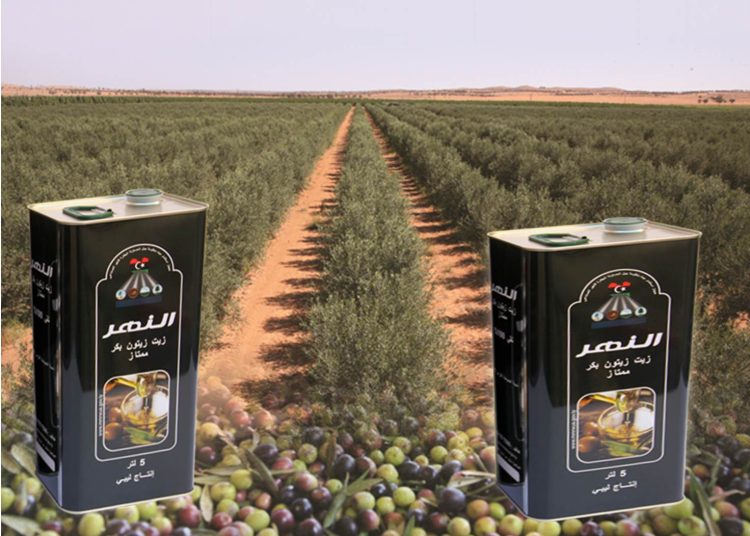After last year’s drought and failed harvest, Libya has witnessed record olive oil production this year. The state agricultural projects established during the Qaddafi regime, especially the Abu Aisha Project and the Tarhuna Agricultural Project, which are part of the Man-Made River’s Water Utilisation Authority. Yields are reported to be good in the Jabal Al-Hasawneh, Al-Jafara, and the cities of Gharian and Msallata too. The state agricultural projects have been planted with the modern high density, annually producing varieties from Spain and Greece.
Al-Nahr oil
In the modern olive press of the Tarhuna Agricultural Project, this year’s harvest is filled according to local and international specifications and standards. It is packed in 5-litre metal cans, not transparent glass, to protect it from light and maintain its quality in accordance with set health standards. Al-Nahr olive oil gives a high degree of quality at a price of 90 dinars per five litre can (US$ 3.6/litre).
A record olive oil harvest expected
In an exclusive interview with the Libya Herald, Ashraf Akak, olive oil producer, owner of the Golden Ghosn press in the Souk Al-Ahad (south of Tripoli) and the head of the Olive Oil Producers Association, confirmed that Libya’s olive oil production is expected to be a record breaker this year.
He put this year’s increase in olive oil production specifically to the spread of the Spanish olive tree varieties grown on farms.
Akak would not commit to a number, saying he would prefer to wait until the end of the harvest season at the end of this February.
Spanish Arbequina olive tree variety for high density planting
Akak said people had become aware of the importance of cultivating the olive tree and taking care of it, especially after the spread of new types of high-density olive trees, including the Arbequina. Arbequina is considered one of the best types of olives and is characterized by its small size, as it is between 2.5-3.0 meters high and 1.2-1.4 meters wide. It produces olives every year and not every other year.
As a result of it, he said, Spain obtained first place in the world with a production of more than 1.5 million tons annually. One of the advantages of Arbequina is the beginning of production from the second year, unlike other traditional types that start production from the eighth to the tenth year.
Greek olive variety Koroneiki for high density planting
Another type of olive tree, he revealed, is the Greek, Koroneiki. Its cultivation has spread in Libya in recent years, and it is used primarily in the production of olive oil. The Koroneiki olive tree is one of the most common types and is suitable for high-density growing systems all over the world from 1,500 to 2,000 trees per hectare and adopts to drip irrigation and harvesting by machines.
10 to 12 million olive trees in Libya
Akak concluded by saying that the olive tree is economically one of the most important trees in Libya, and most of the areas planted with olive trees are concentrated in the areas of the coastal strip where there is rain and a moderate climate.
He added that there are about 10 to 12 million olive trees in Libya producing an average of 20 kg / tree with 3.1 million trees in the desert areas.
He said that despite the scarcity of rain and drought in recent years, this year’s production is very abundant proving that the cultivation of olive trees in Libya a promising and guaranteed future for investment.










